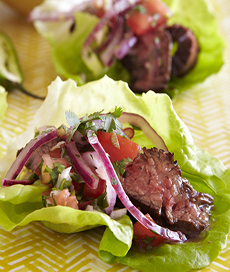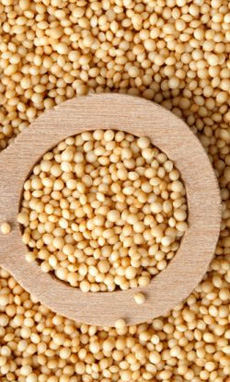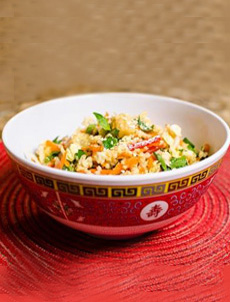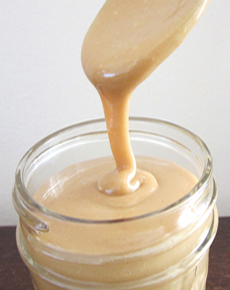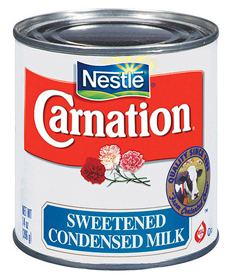|
In the spring, when the blossoms fall from the Asian pear trees, the nascent pears are the size of peas. Now, at harvest time, many are as large as croquet balls, some varieties the size of softballs (and yet low in calories—about 50 per 4 ounces).
If you see a red and white Subarashii Kudamono, the fruits haven’t crossed the Pacific Ocean: They’re grown in Pennsylvania.
While on business in Japan in 1973, American inventor Joel Spira received a gift of Asian pears. Upon returning home, he tried to obtain more of the crunchy, juicy fruit but couldn’t find it. So, he decided to grow his own.
Spira and his wife Ruth (who has a botany degree) purchased orchard land in the fertile Lehigh Valley of eastern Pennsylvania, and set about growing traditional varieties of Asian pears as well as creating new varieties. They named their company Subarashii Kudamono, Japanese for “wonderful fruit.”
Today, thousands of their trees yield numerous varieties of Asian pears. The 2014 harvest has begun, and the fruit is now available at gourmet grocers from New York and New Jersey down to Pennsylvania, Maryland and Virginia, and nationally online at WonderfulFruit.com.
|
|
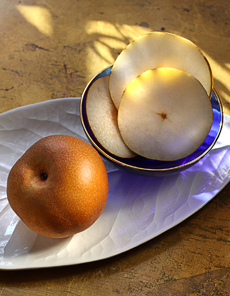
A simple yet elegant dessert. Serve with an optional drizzle of honey. Photo courtesy WonderfulFruit.com. |
|
Asian pears are also grown in California, Oregon and Washington, in addition to orchards worldwide.
So today’s tip is to try Asian pears.
ARE ASIAN PEARS PEARS, APPLES OR A HYBRID?
“Asian pear” is the generic name for more than 25 different varieties of a pear species that originated in Asia. The fruit was first cultivated in what are now China, Japan and Korea, beginning as far back as 330 B.C.E.
Although the shape is reminiscent of some varieties of apples and has the crunchy flesh of apples, the Asian pear, Pyrus pyrifolia, belongs to the same genus as European pears, Pyrus communis. This means you can eat them in the same way, in recipes or as hand fruit, with the skin or peeled.
Don’t expect a creamy European pear texture, though, or any apple flavor from the fruit that is also known as apple pear, Korean pear, Chinese pear and sand pear, among other names.
And unlike European pears, Asian pears don’t soften when ripe. They remain crunchy, even when cooked.
HOW TO SERVE ASIAN PEARS
This fruit is very versatile, pairing well (no pun intended) in savory and sweet recipes. For starters, consider:
Breakfast: Sliced as your morning fruit, atop cereal, baked like a baked apple.
Lunch/Dinner: Sliced into a green salad with blue cheese or feta; diced into chicken salad; julienned into cole slaw; added to stuffing; cooked and puréed into soup; in stir-fries or Asian dishes seasoned with curry powder, five-spice powder, ginger, soy sauce and/or star anise; instead of sautéed apples with ham, pork chops and other proteins.
Dessert: Poached, using your favorite poached pears recipe, baked in tarts, with a cheese plate, served plain with a drizzle of honey.
There are dozens of Asian Pear recipes at WonderfulFruit.com: desserts, salads, slaws, spreads, combined with favorite proteins, even Asian pear fries!
|
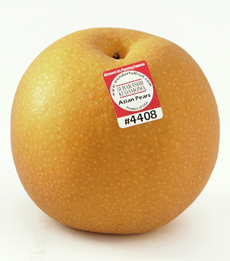
If there’s no sticker, ask the produce
manager about the variety and provenance
of the Asian pears. Photo courtesy
WonderfulFruit.com. |
|
RECIPE: SALAD WITH ASIAN PEARS
You can turn this side salad into a main course by topping it with a grilled protein: chicken breast; fish fillet, scallops or shrimp; lamb, etc.
Ingredients For 4 Servings
4 cups of mixed baby greens
1 head radicchio
2 medium Asian Pears, diced
Blue cheese, feta or goat cheese, crumbled, diced or sliced
For The Dressing
1-1/2 tablespoons white wine vinegar
1/2 teaspoon Dijon mustard
4 tablespoons olive oil
1/2 teaspoon honey
Salt and pepper to taste
|
Preparation
1. TEAR the radicchio into bite-sized pieces and combine with greens in a salad bowl (also tear greens if not using baby greens). Add the diced pears.
2. WHISK the vinegar and mustard, then whisk in the olive oil. Add honey, salt and pepper. Toss with the salad.
3. ADD cheese to top and serve.
TRADITIONAL ASIAN PEAR VARIETIES
Depending on the variety, Asian pears can range from medium to large to extra large. Most colors vary from yellow to tan-brown; some have green or russet hues. Their skin may be smooth or speckled. Some of the most popular varieties grown in the U.S. include Hosui (Golden Russet Brown), Kosui (Golden Russet), Nijiseiki or Twentieth Century (Yellow-Green), Shinseiki (Yellow) and Shinsui (Russet Brown).
These conventional varieties are grown by Subarashii Kudamono:
Atago, often heart-shaped,is exceptionally flavorful. Ripening late in the season, it has a lovely butterscotch colored skin. This fruit is juicy and crunch, with subtle tropical flavors of mango, kiwi and passionfruit plus notes of citrus and melon.
Hosui has a mild, clear, sweet flavor. This crisp and juicy fruit is golden tan in color with a slight conical shape. In Japanese Hosui means sweet water.
Niitaka is a golden light brown in color with a distinctive peaked top. Another very crisp juicy variety, it is sweet with a hint of a nuttiness.
Olympic is very round, khaki (brownish-green) color with a blush of dark red. It has a rich flavor, is lightly crisp and displays a delicate amount of juiciness.
Yoinashi is very sweet, with a hint of butterscotch. It is golden-orange in color and is slightly oval in shape.
The company has also bred and patented five additional varieties: It’s an Asian pear lover’s paradise. One of them, Asaju, is grown artisan-style in a wax-lined bag, so the skin is wafer thin and very crisp.
You can buy them online for yourself or as gifts. A 5-pound gift box is $29.95; a 9-pound gift box is $39.95.
MORE ABOUT ASIAN PEARS.
|
|




